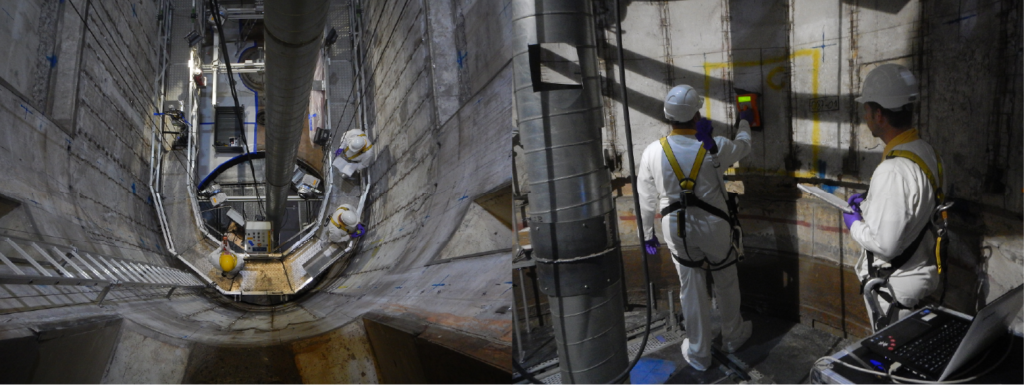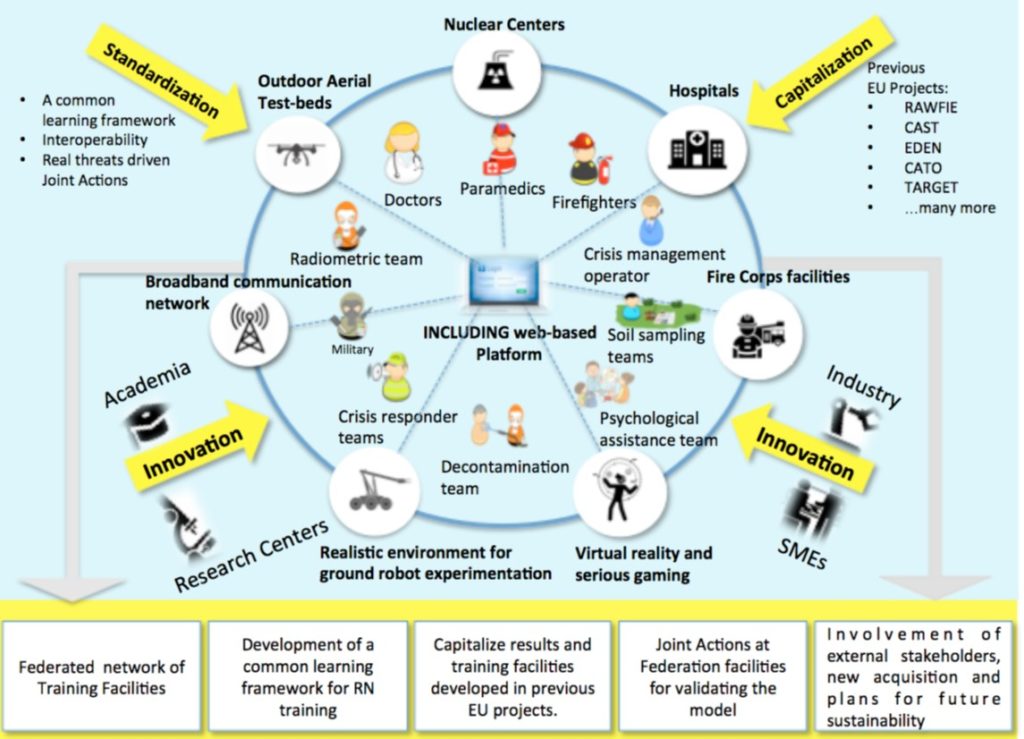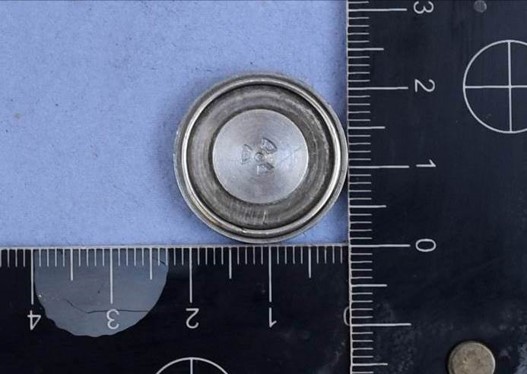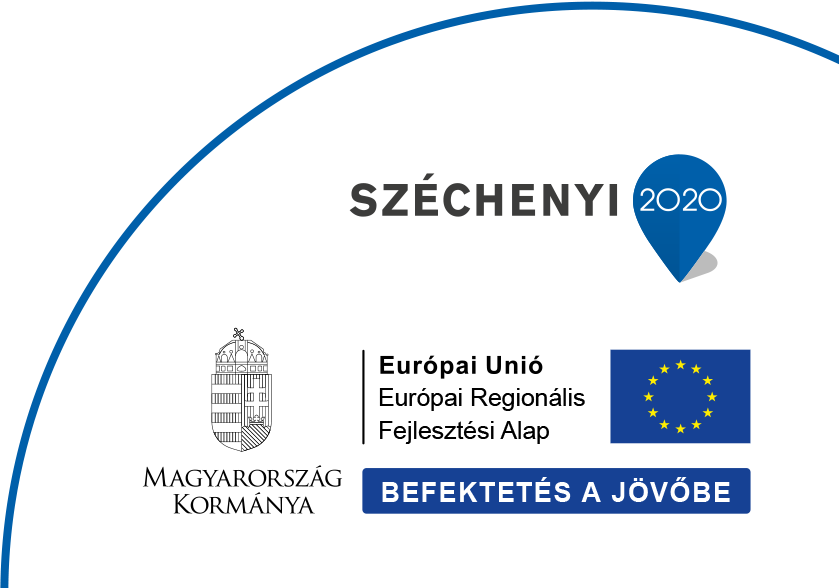Eu FP7 and H-2020 projects in the last decade:
- BOOSTER – BiO-dOSimetric Tools for triagE to Responders, FP7, 2010 – 2013.
Participants: France, Germany, Ireland, Hungary, Spain.
Designed to develop new bio-dosimetric tools in order to quickly evaluate and treat the consequences of a terror attack (e.g. using dirty bomb) by estimating the level of potential casualties, using a developed toolbox, performing an efficient triage of exposed people, training civil protection operators and define commercial exploitation potentialities.

Figure 1. Final demonstration exercise at the premises of EK
- SCINTILLA – Scintillation Detectors and New Technologies for Nuclear Security, FP7, 2012-2014.
Participants: France, Italy, JRC EU, Germany, Hungary, United Kingdom.
To build a comprehensive toolbox of devices based on technologies, with enhanced detection and identification of lost, masked, shielded radioactive sources and nuclear material and to find a replacement for the close to unavailable He-3 in the European Union, the major consumable for today’s RPM (radiation portal monitor) devices.

Figure 2. Radiation portal monitor for vehicle control
- EUROSTARS MIQE 9481 – Mobile Incident Radiation Identification and Quantification Equipment, 2015 – 2017.
Participants: United Kingdom and Hungary.
Development and testing of new mobile gamma and neutron detection systems, capable for the localization and accurate quantitative and qualitative detection of stolen, smuggled, lost or found radioactive and nuclear materials to strengthen nuclear security.

Figure 3. The dynamic (left) and static (right) testing laboratory of EK
- INSIDER – Improved Nuclear Site Characterization for Waste minimization in Decommissioning under Constrained Environment, H-2020, 2016 – 2021.
Participants: France, Belgium, Czech Republic, JRC EU, Germany, Hungary, IAEA, Spain, Switzerland, United Kingdom, Ukraine.
The global project objective is to improve decommissioning and dismantling (D&D) of nuclear facilities with medium and high radioactivity levels and/or other constrained environments from complex non-standard facilities, with regards to waste production. In the frame of the project the gamma spectrometry experts of EK carried out waste characterization measurements at the partly decommissioned zone of the biological shielding of the BR-3 type research reactor of SCK-CEN in Mol, Belgium. Additionally liquid waste from the research reactor of Ispra (JRC) was characterized the EK gamma spectrometry experts.

Figure 4: In situ measurements at SCK CEN (Belgium) reactor pool under decommissioning
- ITRAP+10 Phase II. – Illicit Trafficking Radiation Assessment Program, 2017 – 2019.
Participants: France (2), Germany, Austria, Hungary.
The main goal of the project was to build testing and performance assessment capacity within EU Member States and test commercially available mobile and transportable detection systems (SRPM, RIID, PRD) in 5 different testing laboratories within the EU.

Figure 5. SRPM (left) and RIID (right) tested at the testing laboratory of EK
- C-BORD – effective Container inspection at BORDer control points, H2020, 2015 – 2018.
Participants: France, Germany, Hungary, Italy, The Netherlands, Poland, United Kingdom.
The project aimed at the development and testing of innovative detection technologies developed/improved for more efficient customs control of container freight at sea- and landborders.

Figure 6. Container control by X-ray (left) and personal car check (right) with relocatable detectors at the Hungarian-Serbian landborder crossing place
- INCLUDING – INnovative CLUster for raDIological and Nuclear emerGencies -, H2020, 2019-2023.
Participants: Italy, Austria, Finland, France, Germany, Greece, Hungary, Lithuania, Poland, Portugal.
The project – in the frame of a Federation – aims at the development of a strategy, an architecture and a tool for optimizing the existing resources at EU level and plans to achieve a more effective sharing strategy of facilities and resources. Therefore the main objectives of this project are (1) to develop a mixed training/experimentation environment available for RN practitioners; (2) to develop a centralized management tools for remote booking and utilization of resources; (3) to develop a common framework for RN training and organization of exercise and developing real threats driven exercises at the Federation facilities.

Figure 7. Structure of the developed system in INCLUDING
IAEA Coordinated Research Projects (CRP):
- IAEA CRP J02003 (2013 – 2016) – Establishment of National Library for Nuclear Forensics Purposes in Hungary
The research was focusing on analysis of numerous comparison samples from the same and also different confiscations and batches with different origin. Using the results obtained development of the national nuclear forensics library to aid in national level comparisons of material out of regulatory control.
- IAEA CRP J02012 (2018 – 2022) – Advancing Radiation Detection Equipment for Detecting Nuclear and Other Radioactive Material out of Regulatory Control
A test campaign is being carried out by the Detector Testing Laboratory of the Centre for Energy Research in the frame of a Coordinated Research Project J02012. The research project includes a number of activities related to nuclear security needs in the area of radioisotope identification and the calibration of the identification equipment. Laboratory test measurements with calibrated sources and analysis of the spectra were carried out with a gamma analysis software (FitzPeaks) and a graphing software (Origin) to apply the source-activity measurement method, widely used with high resolution gamma-ray detectors (e.g. High Purity Germanium – HPGe – detector), to RID devices as well. Measurements and analysis of scintillation crystal based Radioisotope Identification Detectors (RID) have been our main focus, to investigate the possibility of source-activity estimation and to develop that possibility with methods, algorithms and specifications.

Figure 8. Comparative measurements of scintillation
material based Radioisotope Identification Detectors (RID)
3 IAEA CRP J02013 (2019 – 2022) – Development of different methods and technologies for effective response to a nuclear security event at the early stages of an investigation.
Nuclear forensic research at EK is focusing on different areas like determination of relevant signatures of sealed radioactive sources; development of new, effective gamma-spectrometric methods for categorization and first in-field characterization of unknown (found or confiscated) nuclear materials (Fig. 8.); development of methods for analysis of radiologically contaminated traditional forensics evidences or establishment of common procedure for radiological crime scene management together with the traditional forensics experts.

Figure 9. Nuclear forensics characterization of neutron sources in the IAEA Coordinated Research Project
